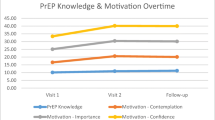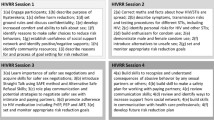Abstract
The epidemiology of HIV infection in the US in general, and in the southeast, in particular, has shifted dramatically over the past two decades, increasingly affecting women and minorities. The site for our intervention was an infectious diseases clinic based at a university hospital serving over 1,300 HIV-infected patients in North Carolina. Our patient population is diverse and reflects the trends seen more broadly in the epidemic in the southeast and in North Carolina. Practicing safer sex is a complex behavior with multiple determinants that vary by individual and social context. A comprehensive intervention that is client-centered and can be tailored to each individual’s circumstances is more likely to be effective at reducing risky behaviors among clients such as ours than are more confrontational or standardized prevention messages. One potential approach to improving safer sex practices among people living with HIV/AIDS (PLWHA) is Motivational Interviewing (MI), a non-judgmental, client-centered but directive counseling style. Below, we describe: (1) the development of the Start Talking About Risks (STAR) MI-based safer sex counseling program for PLWHA at our clinic site; (2) the intervention itself; and (3) lessons learned from implementing the intervention.

Similar content being viewed by others
References
Adamian, M. S., Golin, C. E., Shain, L., & DeVellis, B. (2004). Motivational interviewing to improve adherence to antiretroviral therapy: Development and pilot evaluation of an intervention. AIDS Patient Care STDS, 18(4), 229–238.
Adimora, A. A., Schoenbach, V. J., Martinson, F. E., Coyne-Beasley, T., Doherty, I., Stancil, T. R., & Fullilove, R. E. (2006). Heterosexually transmitted HIV infection among African Americans in North Carolina. Journal of Acquired Immune Deficiency Syndromes, 41(5), 616–623.
Adimora, A. A., & Schoenbach, V. J. (2005). Social context, sexual networks, and racial disparities in rates of sexually transmitted infections. Journal of Infectious Diseases, 191(Suppl 1), S115–S122.
Amrhein, P. C., Miller, W. R., Yahne, C. E., Palmer, M., & Fulcher, L. (2003). Client commitment language during motivational interviewing predicts drug use outcomes. Journal of Consulting and Clinical Psychology, 71(5), 862–878.
Baele, J., Dusseldorp, E., & Maes, S. (2001). Condom use self-efficacy: Effect on intended and actual condom use in adolescents. Journal of Adolescent Health, 28, 421–431.
Baker, A., Healther, N., Wodak, A., Dixon, J., & Holt, P. (1993). Evaluation of a cognitive-behavioral intervention for HIV prevention among injection drug users. AIDS, 7, 247–256.
Baker, A., Kochan, N., Dixon, J., Heather, N., & Wodak, A. (1994). Controlled evaluation of a brief intervention for HIV prevention among injecting drug users not in treatment. AIDS Care, 6, 559–570.
Bandura, A. (1986). Social foundations of thoughts and action: A social cognitive theory. Englewood Cliffs, NJ: Prentice Hall.
Belcher, L., Kalichman, S., Topping, M., Smith, S., Emshoff, J., et al. (1998). A randomized trial of a brief HIV risk reduction counseling intervention for women. Journal of Consulting and Clinical Psychology, 66, 531–541.
Carey, M. P., Maisto, S. A., Forsyth, A. D., Wright, E. M., Johnson, B. T., & Kalichman, S. C. (1997). Enhancing motivation to reduce the risk of HIV infection for economically disadvantaged urban women. Journal of Consulting and Clinical Psychology, 165, 531–541.
Centers for Disease Control and Prevention (2003). HIV/AIDS Surveillance Supplemental Report, 10.
Diorio, C., Resnikow, K., McDonnell, Soet, J., McCarty, F., & Yeager, K. (2003). Using motivational interviewing to promote adherence to antiretroviral medications: A pilot study. Journal of the Association of Nurses in AIDS Care, 14, 52–62.
Dunn, C., Deroo, L., & Rivara, F. P. (2001). The use of brief interventions adapted from motivational interviewing across behavioral domains: A systematic review. Addiction, 96, 1725–1742.
Emmons, K. M., & Rollnick, S. (2001) Motivational interviewing in health care settings. Opportunities and limitations. American Journal of Preventive Medicine, 20, 68–74.
Fishbein, M., & Ajzen, I. (1975). Belief, attitude, intention and behavior: An introduction to theory and research. Reading, MA: Addison-Wesley.
Fishbein, M., & Yzer, M. C. (2003). Using theory to design effective health behavior interventions. Communication Theory, 13, 164–183.
Fisher, J., Willcuts, D. K., Misovich, S., & Weinstein, V. (1998). Dynamics of sexual risk behavior in HIV-infected men who have sex with men. AIDS and Behavior, 2, 101–114.
Golin, C. E., Earp, J. A., Tien, H., Stewart, P., & Howie, L. (2006). A two-arm, randomized, controlled trial of a motivational interviewing-based intervention to improve adherence to antiretroviral therapy (ART) among patients failing or initiating ART. Journal of AIDS.
Golin, C. E., Patel, S., Paulovits, K., & Quinlivan, E. B. (2005). Development and pilot assessment of a motivational interviewing-based “prevention for positives” program. In Proceedings of the CDC prevention conference, Atlanta, GA.
Group SSASDW. (2003). Southern States Manifesto: HIV/AIDS and STD’s in the South.
Hader, S. L., Smith, D. K., Moore, J. S., & Holmberg, S. D. (2001). HIV infection in women in the United States: Status at the millennium. Journal of the American Medical Association, 285, 1186–1192.
Holmes, R., Fawal, H., Moon, T. D., et al. (1997). Acquired immunodeficiency syndrome in Alabama: Special concerns for black women. Southern Medical Journal, 90, 697–701.
Kaiser Family Foundation (2002). HIV/AIDS and other sexually transmitted diseases in the southern region of the United States: Epidemiological overview. Menlo Park, CA: Kaiser Family Foundation.
Kalichman, S. C. (2005) Positive prevention: Reducing HIV transmission among people living with HIV/AIDS. New York: Kluwer Academic/Plenum Publishers.
Kalichman, S. C., Kelly, J. A., Morgan, M., & Rompa, D. (1997a). Fatalism, current life satisfaction, and risk for HIV infection among gay and bisexual men. Journal of Consulting and Clinical Psychology, 65, 542–546.
Kalichman, S. C., Nachimson, D., Cherry, C., & Williams, E. (1998). AIDS treatment advances and behavioral prevention setbacks: Preliminary assessment of reduced perceived threat of HIV-AIDS. Health Psychology, 17, 546–550.
Kalichman, S. C., Roffman, R., Picciano, J., & Bolan, M. (1997b). Sexual relationships, sexual behavior, and human immunodeficiency virus infection: Characteristics of HIV seropsoitive gay and bisexual men seeking prevention services. Professional Psychology: Research and Practice, 28, 355–360.
Kalichman, S. C., Rompa, D., Cage, M., DiFonzo, K., Simpson, D., Austin, J., Luke, W., Buckles, J., Kyomugisha, F., Benotsch, E., Pinkerton, S., & Graham, J. (2001). Effectiveness of an intervention to reduce HIV transmission risks in HIV-positive people. American Journal of Preventive Medicine, 21, 84–92.
McKee, M. B., Picciano, J. F., Roffman, R. A., Swanson, F., & Kalichman, S. C. (2006). Marketing the ‘sex check’: Evaluating recruitment strategies for a telephone-based HIV prevention project for gay and bisexual men. AIDS Education and Prevention, 18(2), 116–131.
Miles, M. B., & Huberman, M. (1994). Qualitative data analysis. Thousand Oaks, CA: Sage Publications.
Miller, W. R. (2000). Motivational interviewing skill code (MISC): Coder’s manual. Albuquerque, New Mexico: University of New Mexico.
Miller, W. R., & Rollnick, S. (2002). Motivational interviewing: Preparing people for change (2nd ed., p. 58). New York: Guilford Press.
MMWR (2005). HIV transmission among black women—North Carolina. Morbidity and Mortality Weekly Report, 54, 89–94.
Napravnik, D., McKaig, R. G., Menezes, P., Haskins, L. M., Buerge, S. S., Abernathy, M. G., van Der Horst, C., & Eron, J. J. (2002). Prevalence and characteristics of HIV-infected individuals who engage in high risk sexual behavior. In Proceedings of the XIV international AIDS conference, Barcelona, Spain, Abstract WePeC6089.
Napravnik, S., Edwards, D., Stewart, P., Stalzer, B., Matteson, E., & Eron, J. J., Jr. (2005). HIV-1 drug resistance evolution among patients on potent combination antiretroviral therapy with detectable viremia. Journal of Acquired Immune Deficiency Syndrome, 40, 34–40.
NC-DHHS, Epidemiology and Special Studies Unit—HIV/STD Prevention and Care Branch Epidemiology Section—Division of Public Health—NC Department of Health and Human Services Updated October 2006 http//www.epi.state.nc.us/epi/hiv/surveillance.html.
Picciano, J. F., Roffman, R. A., Kalichman, S. C., Rutledge, S. E., & Berghuis, J. P. (2001). A telephone based brief intervention using motivational enhancement to facilitate HIV risk reduction among MSM: A pilot study. AIDS and Behavior, 5, 251–262.
Reitman, D., St. Lawrence, J., Jefferson, K. W., Alleyne, E., Brasfield, T. L., & Shirley, A. (1996). Predictors of African American adolescents’ condom use and HIV risk behavior. AIDS Education and Prevention, 8, 499–515.
Remien, R. H., Carballo-Dieguez, A., & Wagner, G. (1995). Intimacy and sexual behavior in serodiscordant male couples. AIDS Care, 7, 429–438.
Resnicow, K., Jackson, A., Wang, T., De, A. K., McCarty, F., Dudley, W. N., & Baranowski, T. (2001). A motivational interviewing intervention to increase fruit and vegetable intake through black churches: Results of the eat for life trial. American Journal of Public Health, 91(10), 1686–1693.
Robinson, B. E., Bockting, W. O., Rosser, B. R. S., Miner, M., & Coleman, E. (2002). The sexual health model: Application of a sexological approach to HIV prevention. Health Education Research, 17, 43–57.
Rollnick, S., Heather, N., & Bell, A. (1992). Negotiating behaviour change in medical settings: The development of brief motivational interviewing. Journal of Mental Health, 1, 25–37.
Rollnick, S. (2001). Comments on Dunn et al.’s the use of brief interventions adapted from motivational interviewing across behavioral domains: a systematic review. Enthusiasm, quick fixes and premature controlled trials. Addiction, 96, 1769–1770; discussion 1774–1775.
Rotheram-Borus, M. J., Reid, H., Rosario, M., & Kasen, S. (1995). Determinants of safer sex patterns among gay/bisexual male adolescents. Journal of Adolescence, 18, 3–15.
Safren, S. A., Otto, M. W., Worth, J. L., Salomon, E., Johnson, W., Mayer, K., & Boswell, S. (2001). Two strategies to increase adherence to HIV antiretroviral medication: Life-steps and medication monitoring. Behaviour Research and Therapy, 39, 1151–1162.
SSASDW (2003). Southern States Manifesto. HIV/AIDS and STDs in the South: A call to action. Atlanta, GA: National Center for HIV/STD, and TB Prevention, Div of HIV/AIDS Prevention.
Strang, J., McCambridge, J., Platts, S., & Groves, P. (2004). Engaging the reluctant GP in care of the opiate misuser: Pilot study of change-orientated reflective listening (CORL). Family Practice, 21(2), 150–154.
Strauss, R., Shain, L., Baggstrom, E., et al. (2001). Sexual behaviors in persons living with HIV/AIDS in the non-urban southeast US. Presented at the 129th Annual Meeting of the American Public Health Association, Atlanta, GA, Abstract 6013.0.
Thrasher, A., Golin, C. E., Earp, J. A., Porter, C., & Tien, H. (2006). Motivational interviewing to improve antiretroviral adherence: The role of quality assessment. Patient Education and Counseling, 62, 64–71.
Wingood, G. M., DiClemente, R. J., Mikhail, I., Lang, D. L., McCree, D. H., Davies, S. L., Hardin, J. W., Hook, E. W. III, & Saag, M. (2004). A randomized controlled trial to reduce HIV transmission risk behaviors and sexually transmitted diseases among women living with HIV: The WiLLOW program. Journal of Acquired Immune Deficiency Syndromes, 37, S58–S67.
Acknowledgments
We would like to thank Ross Oglesbee for her administrative and editorial assistance on this manuscript. This research was supported by a Special projects of National Significance (SPNS) grant from Health Resources Services Administration (No. HA01289-02) and by the University of North Carolina Center for AIDS Research (P30 AI50410).
Author information
Authors and Affiliations
Corresponding author
Rights and permissions
About this article
Cite this article
Golin, C.E., Patel, S., Tiller, K. et al. Start Talking About Risks: Development of a Motivational Interviewing-Based Safer Sex Program for People Living with HIV. AIDS Behav 11 (Suppl 1), 72–83 (2007). https://doi.org/10.1007/s10461-007-9256-1
Received:
Accepted:
Published:
Issue Date:
DOI: https://doi.org/10.1007/s10461-007-9256-1




